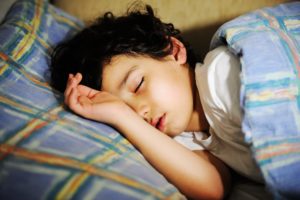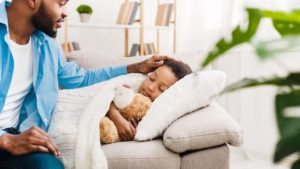When you buy through our links, we may earn a commission. Products or services may be offered by an affiliated entity. Learn more.
How Blue Light Affects Kids’ Sleep
- Blue light from screens disrupts children’s sleep by disrupting their sleep-wake cycle.
- Light sensitivity during adolescence greatly affects the production of sleep-inducing melatonin.
- Sleep is crucial for children in school and excessive screen time can lead to symptoms of insomnia, difficulty staying asleep, and a lack of focus the next day.
- Parents should set limits on screen time, lead by example, and communicate with their children about the importance of sleep.
Electronic devices have become an integral part of most children’s lives. Kids use screen-based electronics throughout the day for schoolwork, entertainment, communication, and more. While technology offers countless educational and social benefits, there are also downsides to our widespread, easy access to these devices – including the impact technology may be having on sleep.
What Is Blue Light?
The full spectrum of visible light consists of varied light wavelengths. Violet light has the shortest wavelength , while red light wavelengths are the longest. Blue light is a short wavelength type of light that promotes alertness and performance . Blue light is also the most important regulator of our sleep-wake cycle or circadian rhythm.
Common Sources of Blue Light
The screens of televisions, smartphones, tablets, computers, gaming systems, and certain e-readers all produce artificial blue light. However, we aren’t exposed to blue light solely through electronics. We get most of our blue light exposure from the sun. Additionally, LED and fluorescent light bulbs produce blue light.
Blue Light and Melatonin
Blue light suppresses the production of melatonin, a hormone that promotes feelings of sleepiness. Humans evolved to maintain a sleep-wake cycle based around the rising and setting of the sun. When we only receive natural sunlight, our melatonin levels are low during the day, but they start to rise after sunset. They reach their highest point in the middle of the night and then slowly decrease until morning.
Exposure to blue light during the day from sunlight or other sources is a healthy promoter of energy and concentration. Daytime blue light exposure has also been shown to improve sleep quality and duration. However, using devices that produce artificial blue light in the evening and nighttime disrupts our natural sleep-wake cycle by tricking the brain into not producing melatonin before bed. This causes us to feel less sleepy than we should at bedtime.
Help Your Child Sleep Better With Pediatric Sleep Coaching

our partner at sleepdoctor.com
Learn More“Life-changing! My anxiety about my son’s sleeping habits were immediately reduced after talking to Sara. She went above and beyond to tailor a schedule to our goals, answer our questions, keep us on track, and check in to encourage us when we just thought we couldn’t do it anymore.”
Rachael B. – Verified Customer
How Does Blue Light Affect Children?
The general principles of light affecting melatonin production and sleep apply to both children and adults. However, children may be even more sensitive to light. As we age, structures in our eyes gradually become less sensitive to light . Children also have larger pupils than adults. A research study found that evening light exposure suppressed melatonin twice as much in children compared to adults. A child’s age and developmental stage may also determine the impact. Researchers found that children who had not yet gone through puberty experienced significantly more melatonin suppression in response to evening light compared with post-puberty adolescents.
Does Blue Light Cause Sleep Issues in Children?
Observational studies from around the world have shown that screen use by children is associated with later bedtimes and less time spent asleep. While these observational studies cannot prove a cause-and-effect relationship, numerous studies in adults have demonstrated that light exposure in the evening and the use of blue light-emitting devices before bed affect sleep. This evidence, combined with the data showing that children have an increased sensitivity to light-related melatonin suppression, suggests that the sleep-disrupting effects of blue light may apply to children as well.
However, more research is needed to illuminate whether blue light causes disrupted sleep or if children who already struggle with sleep are more likely to use screens (and be exposed to blue light) before bed and at night. It is possible that these two factors may share a bidirectional relationship , meaning that sleep affects screen time use, and screen time use affects sleep.

How Can You Reduce Exposure to Blue Light?
Given the importance of sleep for a child’s mental and physical health, ensuring that children are consistently getting enough sleep at night is critical. If you are concerned about the impact blue light exposure may be having on your child’s sleep, there are a number of steps you and your child can take. Start by trying the following interventions:
- Set a technology curfew: Establish a nightly schedule that involves ceasing the use of electronics one hour before bedtime. You can use an alarm to help a child remember to turn off screens at a certain time. It might help to plan other calming activities before bed, such as reading, coloring, painting, or stretching. Parents should also lead by example and limit the use of screens prior to bedtime.
- Create technology-free zones: Storing phones and other devices outside of the bedroom may be a difficult transition for some kids, but it can have a big impact on nighttime blue light exposure. It reduces the temptation to use devices before going to sleep and eliminates the possibility of being woken up by texts, calls, and other alerts.
- Use blue light filters: Special glasses that filter out blue light may help combat the adverse effects of blue light exposure before bed. Blue light-filtering apps are also an option. They shift the color tone of a tablet or smartphone screen toward warmer wavelengths of the light spectrum.
- Alter settings: Many electronic devices include options for “night mode” or “dark mode” that change the screen background to black, reducing blue light exposure.
- Switch to red lights: Red light exposure does not suppress melatonin proRetrieved July 23, 2023, fromduction , so it could help to use red light bulbs for evening reading lamps and nightlights. Yellow light and orange light are also on the long wavelength end of the light spectrum and could be good options.
- Ensure daytime light exposure: Getting exposed to bright light during the day helps to synchronize circadian rhythms and promotes sleepiness at bedtime. Make sure your child gets plenty of bright, natural daytime light.
It can be a struggle to navigate setting rules and boundaries around screen use, especially for teens. Talk with your child or teen frequently about the role of sleep in their physical and emotional health and the harmful effects blue light may have on sleep. It might help to work together on establishing rules for technology use. Parents and guardians can also model healthy sleep habits, including following a technology curfew and storing electronics outside the bedroom.

Still have questions? Ask our community!
Join our Sleep Care Community — a trusted hub of sleep health professionals, product specialists, and people just like you. Whether you need expert sleep advice for your insomnia or you’re searching for the perfect mattress, we’ve got you covered. Get personalized guidance from the experts who know sleep best.
References
10 Sources
-
National Aeronautics and Space Administration, Science Mission Directorate. (2010). Visible Light., Retrieved July 23, 2023, from
https://science.nasa.gov/ems/09_visiblelight -
Wahl, S., Engelhardt, M., Schaupp, P., Lappe, C., & Ivanov, I. V. (2019). The inner clock-Blue light sets the human rhythm. Journal of biophotonics, 12(12), e201900102.
https://pubmed.ncbi.nlm.nih.gov/31433569/ -
Turner, P. L., & Mainster, M. A. (2008). Circadian photoreception: ageing and the eye’s important role in systemic health. The British journal of ophthalmology, 92(11), 1439–1444.
https://pubmed.ncbi.nlm.nih.gov/18757473/ -
Blume, C., Garbazza, C., & Spitschan, M. (2019). Effects of light on human circadian rhythms, sleep and mood. Somnologie : Schlafforschung und Schlafmedizin = Somnology : sleep research and sleep medicine, 23(3), 147–156.
https://pubmed.ncbi.nlm.nih.gov/31534436/ -
Higuchi, S., Nagafuchi, Y., Lee, S. I., & Harada, T. (2014). Influence of light at night on melatonin suppression in children. The Journal of clinical endocrinology and metabolism, 99(9), 3298–3303.
https://academic.oup.com/jcem/article/99/9/3298/2538381 -
Crowley, S. J., Cain, S. W., Burns, A. C., Acebo, C., & Carskadon, M. A. (2015). Increased Sensitivity of the Circadian System to Light in Early/Mid-Puberty. The Journal of clinical endocrinology and metabolism, 100(11), 4067–4073.
https://pubmed.ncbi.nlm.nih.gov/26301944/ -
Hale, L., Kirschen, G. W., LeBourgeois, M. K., Gradisar, M., Garrison, M. M., Montgomery-Downs, H., Kirschen, H., McHale, S. M., Chang, A. M., & Buxton, O. M. (2018). Youth Screen Media Habits and Sleep: Sleep-Friendly Screen Behavior Recommendations for Clinicians, Educators, and Parents. Child and adolescent psychiatric clinics of North America, 27(2), 229–245.
https://pubmed.ncbi.nlm.nih.gov/29502749/ -
Lee, S. I., Matsumori, K., Nishimura, K., Nishimura, Y., Ikeda, Y., Eto, T., & Higuchi, S. (2018). Melatonin suppression and sleepiness in children exposed to blue-enriched white LED lighting at night. Physiological reports, 6(24), e13942.
https://pubmed.ncbi.nlm.nih.gov/30556352/ -
Magee, C. A., Lee, J. K., & Vella, S. A. (2014). Bidirectional relationships between sleep duration and screen time in early childhood. JAMA pediatrics, 168(5), 465–470.
http://archpedi.jamanetwork.com/article.aspx?doi=10.1001/jamapediatrics.2013.4183 -
Centers for Disease Control and Prevention. (2020, April 1). The Color of the Light Affects the Circadian Rhythms.
https://www.cdc.gov/niosh/emres/longhourstraining/color.html




















